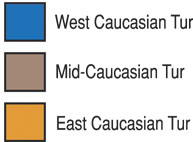 |
 |
Capra cylindricornis
Tur oriental (Sp), Ostkaukasischer Tur (G), Tur du Caucase oriental (F). Also called Dagestan tur, or Pallas tur after 18th century German zoologist Peter S. Pallas, or Caucasian bharal because its horns resemble those of a blue sheep.
DESCRIPTION (males) Shoulder height 31-39 inches (79-98 cm). Weight 120-175 pounds (55-80 kg), sometimes to 220 pounds (100 kg). The female is about 20 percent smaller.
Somewhat smaller and decidedly darker in color than the west Caucasian tur. The coat is uniformly reddish-brown in summer, with underparts whitish and the tail, breast and lower legs darker. Turns a uniform dark brown in winter, with underparts slightly lighter and the tail, breast and lower legs much darker. There is a small white rump patch. Beard is dark and very short (up to three inches, or 76 mm, in length), and difficult to detect in some animals. The horns are quite unusual for a goat, being smooth and rounded, curving above and behind the neck (supracervical), with the tips turning inward and upward; they are quite similar to those of the Himalayan blue sheep or bharal, but are more massive. Females have short, thin horns that grow outward, upward and back.
BEHAVIOR Gregarious, sometimes in large herds numbering several hundred. Males and females keep separate except during mating season. Prefers to feed on forbs and grasses, but will browse. Obtains water from small pools high in the mountains. An extremely good climber as are all goats. Predators are wolves and occasionally leopards. Sometimes killed by avalanches.
HABITAT Usually in open, precipitous terrain at higher elevations (as high as 12,000 feet or 3,650 m), but may also be found lower down in thick forest. Descends to lower elevations in winter to escape heavy snow.
DISTRIBUTION Eastern part of the Caucasus Mountains east of Mt. Dykhtau.
REMARKS The Dagestan tur, like all tur, is a very fine and sporting game animal. It is hunted in steep, high mountains where good physical condition is a must, long shots may be required, and even an average trophy is something to be proud of. Weather in this region is much better than in the western Caucasus.
|





